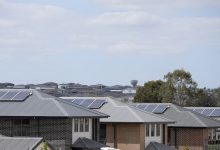Rewiring Australia has called on the federal government to set aside more than $12 billion in the upcoming federal budget to help fast-track the electrification of homes and businesses.
In a week where the Albanese government has splashed $A368 billion on a fleet of nuclear powered submarines many of us will never see, Rewiring Australia co-founders Saul Griffith and Dan Cass argue the relatively small spend of $12.5 billion will deliver fast and deep benefits.
The first major win from electrification would be for voters, with the swapping out of gas stoves, heaters and water, as well as petrol fuelled cars with zero emission electric equivalents promising to slash household energy bills by up to $5000 a year.
The second win would be for the climate – and by association the Albanese government – with the electrification of homes and businesses presenting one of the easiest, cheapest and most effective ways to slash emissions.
What’s needed to achieve these easy wins is some targeted funding and a government-backed plan.
In a budget pre-submission, Rewiring Australia calls for a $500 million package of exepnditure over five years plus $2 billion off-budget from existing Clean Energy Finance Corporation funds, to achieve wide-spread adoption of electrification.
The group says the CEFC funds could be redirected as concessional finance to accelerate electrification. Two-thirds of this would be directed to at least partly electrify 500,000 households, with the remainder targeted to businesses.
Rewiring Australia’s submission highlights the need for subsidies to be carefully designed to avoid harming industry groups who will do the work of electrification.
It also urges the government to consult early with the Smart Energy Council, unions and other industry bodies on subsidy design and the timing of announcements.
“[Australians] want the government to help them fully electrify their homes because they know it will permanently obliterate both their energy bills and carbon emissions,” Griffith says. “We have to grasp this opportunity and bring the whole community along.
“Focusing our electrification efforts on low income and social housing communities is the right thing to do but it’s also smart.
“Freeing these communities of fossil fuel power bills will give them a massive economic boost and create enormous job opportunities,” he said.
Cass says Rewiring Australia’s hope is that its submission and detailed breakdown of how funds should be distributed will help federal Labor meet its stated goal of providing “meaningful and substantial package” of electrification measures in this year’s budget.
“With the right investments now we can empower households for decades to come, garner powerful insight and then sell that expertise to the world. With planning and investment, electrification is an enormous opportunity for Australia,” Cass says.
Rewiring Australia’s key recommendations include:
– At least $2 billion of existing Clean Energy Finance Corporation funds redirected as concessional finance to accelerate electrification. Two-thirds of this would be directed to at least partly electrify 500,000 households, with the remainder targeted to businesses.
– $200 million for Solar Electric Suburb lighthouse projects, where whole suburb pilots will provide a living laboratory to develop home energy management systems, grid integration, and policy and regulatory solutions.
– $200 million in grants for low-income households and disadvantaged communities to help pay for the purchase of efficient electric devices, solar and storage and e-bikes or EVs.
– $95 million in community integrated EV charging infrastructure. This would accelerate electrification by turning EV batteries into virtual power plants, optimising charging across the community and optimising the role of batteries to support the grid. The funding would test models around co-location of EV chargers with community facilities and would allow purchase of land.
– $11 million to establish a new government Office of Electrification within the Department of Climate Change, Energy, the Environment and Water, leading delivery of the Power to the People and Solar Banks programs, co-ordinating research, policy and leading Solar Electric Suburb lighthouse projects.
– $9 million to develop an Integrated Electrification Plan for COAG covering demand side energy and network planning. This would include research for an optimal ‘grid neutral’ market design that empowers households to sell excess electricity back into the market with the same ease as large energy providers.
– $14 million for public education and thought leadership. As with rooftop solar, ordinary people should lead electrification with government funding public education programs to give communities the tools they need to make informed decisions.










